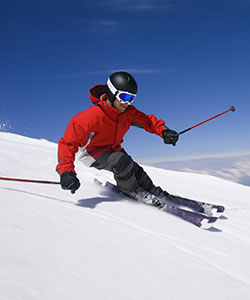(ProActive Sports Rehab offers a weekly column promoting health, fitness and physical therapy. Please be sure to check back each week for a new topic!)
The most common injuries in skiing happen to the lower limb, most commonly the knee. The introduction of releasable bindings has decreased the rate of leg fractures by 90 percent in the past 30 years, but knee sprains (including ACL and/or MCL tears) are on the rise accounting for about 30 percent of all skiing injuries.
The most common injury is the medial collateral ligament (MCL) tear, which is typically treated without surgery. In skiing, the MCL is often torn when the ski tips are pointed toward one another in a snowplow position (the common slow or stop position) and the skier falls down the hill. MCL tears are more common among beginning and intermediate skiers than advanced and elite skiers. When skiing you may prevent an MCL tear by:
• Making sure that your weight is balanced when you are in the snowplow position.
• Sticking to terrain that is a comfortable challenge but not overwhelming.
The second most common injury is the anterior cruciate ligament (ACL) tear. Given the importance of the ACL to the functional stability of the knee, ACL tears often require surgery (however in some cases patients can avoid surgery). ACL tears are common in sports, but most of them are the result of “non-contact” injuries.
There are two ways that skiers most commonly tear the ACL:
• Landing a jump in poor form. When skiers land from a jump with their weight back, so the back of the boot is pushing on the calf, the force from landing can tear the ACL. The best way to avoid this injury is to learn to land safely, with your weight forward, by starting with simple jumps and gradually advancing to more difficult jumps.
• The “phantom foot” phenomenon often happens when skiers try to stand up to prevent an unavoidable fall. As the skier falls, all the weight goes on the outside of one ski, and the arms and trunk rotate away from that leg. When a skier falls into this position, an ACL injury is often the result. Avoid this position by never trying to stand up during a fall and accepting an unavoidable fall. Skiers should “go” with the momentum of a fall and maintaining good ski technique.
Preventing injury on the slopes
Remember the keys to effective skiing technique: Hands and weight forward, legs parallel, and hips, knees and ankles flexing equally.
Stay on marked trails: Going off trail can take you into ungroomed territory with many possible obstacles (such as trees and rocks) that can contribute to injuries.
Getting ready for the slopes
Prepare your body. A few simple exercises can prepare your core and lower extremities for skiing. Three to four weeks of aerobic training such as walking, elliptical or biking can be excellent ways to help you tolerate a full day on the slopes.
Ensure you have proper equipment: Make sure ski boots, bindings, and ski length are fit and appropriate for your height and skill level. Wear a helmet. Wrist guards are a good idea if snowboarding.
Learn proper technique: Take a skiing technique class with a professional before you hit the slopes.
Rest: If you are tired, rest. Injuries happen more commonly when skiers are fatigued.
— American Physical Therapy Association
ProActive Sports Rehab, with offices in Hamburg and West Seneca, offers one-on-one physical therapy and rehabilitation services. For more information, please visit http://proactivesportsrehab.com or call 674-9600 (West Seneca office) or 648-8700 (Hamburg office). You can also follow ProActive Sports Rehab on Facebook at www.facebook.com/ProActiveSportsRehab for frequent updates.




